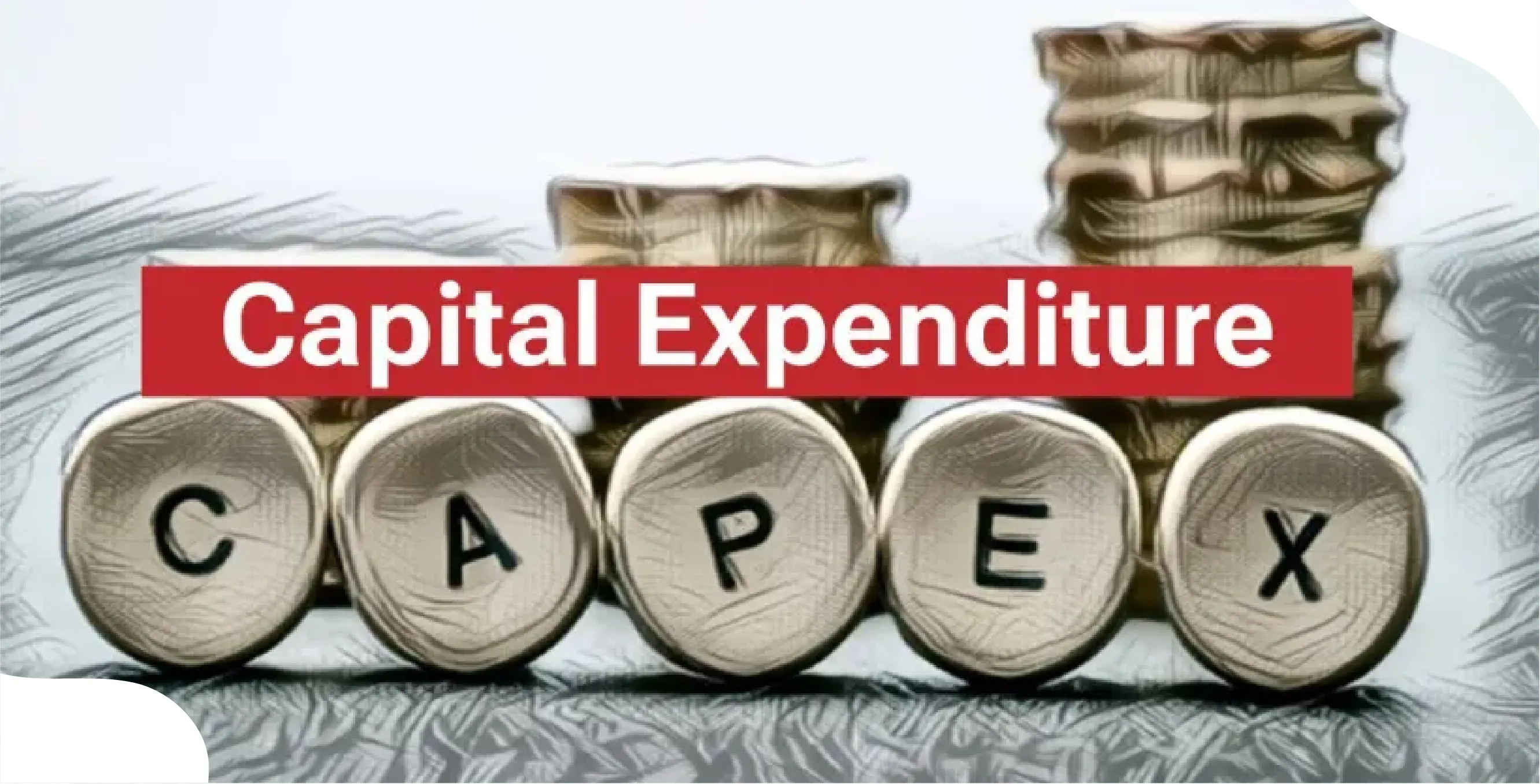
Author
LoansJagat Team
Read Time
5 Min
29 Jul 2025
What Is Capital Expenditure? Meaning, Examples & Accounting Impact
Capital Expenditure is the money spent by a company to acquire or upgrade long-term assets, such as machines, buildings, or equipment.
In April 2024, a small bakery in Lucknow run by Mrs. Sharma bought a new oven for ₹3,00,000. This oven was expected to work for 10 years. She also repainted her shop for ₹30,000. The oven was counted as Capital Expenditure, while the paint was not. Why? Because the oven would help her business for many years.
As per accounting rules, only long-term benefits are treated as Capital Expenditure. The oven's cost was not shown fully in one year, but it was spread over its useful life. Mrs. Sharma was told by her CA, “Yeh investment future ke liye hai, income ke liye.”
This simple case helps explain how Capital Expenditure works. This blog will help you understand what Capital Expenditure means, how it is treated in accounting, and why it matters for long-term business growth.
Introduction to Capital Expenditure
Capital Expenditure refers to the money that is spent by a business to acquire or improve large assets that last for a long time. These assets are not meant for daily use, but they support the business over several years. Examples include machinery, land, buildings, and equipment.
Such assets are used in places like factories, schools, hospitals, and shops. Unlike daily expenses such as salaries or electricity, these costs are not shown fully in one year. Instead, they are recorded on the balance sheet and slowly reduced over time using depreciation.
Let’s take an example. Mr. Arjun, who runs a printing press in Jaipur, bought a new machine for ₹5,00,000. The machine will be used for the next 10 years. So, the cost was not treated like a regular monthly expense. It was recorded as Capital Expenditure, because it would help his business for many years. His accountant told him, “Yeh kharcha aaj ka nahi, kal ka hai.”
As Raj from DDLJ says, “Bade bade shehron mein aisi chhoti chhoti investments hoti rehti hain.” This kind of spending helps a business grow slowly and steadily over time.
Types of Capital Expenditure:
Capital Expenditure means money spent to buy or fix things that help a business for a long time. There are three types of Capital Expenditure. Each one is used for a different reason.
1. Maintenance Capital Expenditure: This type is used to keep things working. For example, if a company changes an old machine part to stop it from breaking, it is maintenance CapEx.
2. Growth Capital Expenditure: This is used when a business wants to grow. Let’s say a bakery in Indore buys two ovens for ₹4,00,000 to bake more bread. That is Capital Expenditure because it helps the business grow.
3. Strategic Capital Expenditure: This is used for big plans. For example, if a business opens shops in a new city to reach more people, it is called strategic CapEx.
As Babu Rao from Phir Hera Pheri would say, “Risk hai toh ishq hai” — but it’s a smart risk.
Difference Between Capital and Revenue Expenditure:
Mr. Kapoor owns a small gym in Delhi. In April, he bought a new treadmill for ₹1,20,000. This treadmill will be used for many years. So, this cost was treated as Capital Expenditure.
Later that month, another treadmill broke. He paid ₹5,000 to get it repaired. That repair was needed for the machine to keep working. It helped just for now. So, it was counted as Revenue Expenditure.
Read More – It Smart To Take A Business Loan
In simple words:
Capital Expenditure is used for buying big things that last a long time.
Revenue Expenditure is used for small, daily costs that help for a short time.
Comparison of Capital and Revenue Expenditure
Capital and revenue expenditures are two important classifications in accounting, each serving a different purpose in financial reporting. The table below outlines their main differences in terms of duration, treatment, and examples:
Capital Expenditure in Accounting:
When big things are bought for a business, the cost is not shown as an expense right away. Instead, it is spread across many years. This method is called capitalisation.
In accounting, a small part of the cost is counted as an expense every year. This is called depreciation. It is done so that profits don’t drop all at once. The full amount is written slowly, over the life of the asset.
Example: A hotel in Pune got a new elevator. It cost ₹15,00,000. This elevator will work for 15 years. So, ₹1,00,000 was shown as an expense every year using depreciation. The elevator was shown as an asset, not a one-time cost.
Accounting Treatment of Capital Expenditure:
Importance of Capital Expenditure for Growth:
When money is spent on new tools, machines, or buildings, it helps a business grow. It can increase how much work is done, help earn more income in the future, and keep the business modern. Businesses must keep improving if they want to stay ahead in the market.
Example: Nita runs a tailoring shop. She spent ₹90,000 to buy 3 new sewing machines. After that, her team finished double the orders in less time. In just 6 months, this Capital Expenditure helped boost her sales.
Risks and Challenges in Capital Expenditure:
Capital Expenditure is helpful but risky. The amount is usually big. So, it must be planned carefully.
If a bad choice is made, the money can get locked. Some machines may also get old fast. Also, sometimes the benefit comes late, not right away.
Also Read - How to Calculate Depreciation
Example: A mobile repair shop spent ₹2,00,000 on new tools. But within a year, better tools were made. The tools they bought were not useful anymore. This Capital Expenditure became a loss.
Capital Expenditure and Budgeting:
Before money is spent, a CapEx budget is made. This budget is checked and approved. Return on Investment (ROI) is also studied.
Even the government makes a CapEx plan to spend on roads, hospitals, and schools.
Example: A city office made a plan to spend ₹50 crore on roads and bridges in 2025–26. This was added to their Capital Expenditure list for the year.
Sample Capital Expenditure Budget
Capital Expenditure in Different Sectors:
Capital Expenditure is used in many areas. Each sector needs different assets. These are some common examples:
Manufacturing: Machines, tools, warehouses
Education: Computers, desks, blackboards
Retail: POS systems, display fridges
Healthcare: MRI machines, hospital beds
Example: A hospital in Pune bought an MRI machine for ₹1.2 crore. It will be used for the next 10 years. It was recorded as Capital Expenditure and written off slowly using depreciation.
Conclusion:
Capital Expenditure is a key part of any business or government’s long-term success. It creates assets, improves growth, and boosts productivity. But it must be planned carefully, tracked properly, and used wisely. A small mistake can waste a lot of money. As they say in Bollywood, “Risk toh hai, par reward bhi bada hai!” Understanding Capital expenditure helps businesses grow in the right direction.
FAQs:
Q1. Is salary Capital Expenditure?
No, Salary is revenue expenditure.
Q2. Is land a Capital Expenditure?
Yes, land is a capital asset.
Q3. Can Capital Expenditure be depreciated?
Yes, except for land.
Q4. Where is Capital Expenditure shown?
On the balance sheet.
Q5. Is painting a Capital Expenditure?
No, usually it is a revenue expense.
Other Informative Pages | |||
About the Author

LoansJagat Team
‘Simplify Finance for Everyone.’ This is the common goal of our team, as we try to explain any topic with relatable examples. From personal to business finance, managing EMIs to becoming debt-free, we do extensive research on each and every parameter, so you don’t have to. Scroll up and have a look at what 15+ years of experience in the BFSI sector looks like.

Quick Apply Loan
Subscribe Now
Related Blog Post


